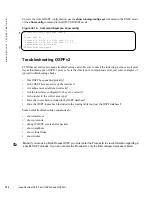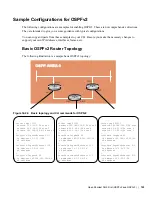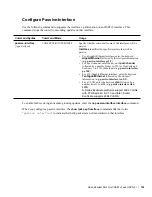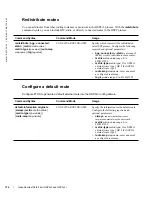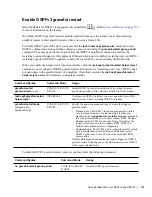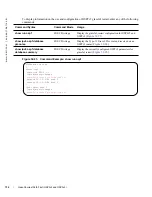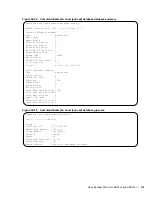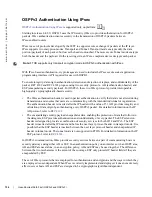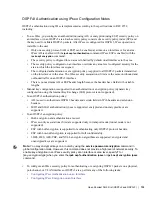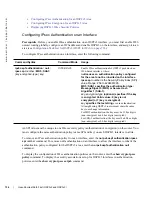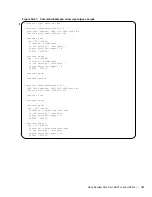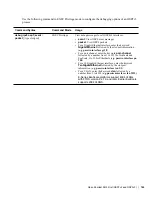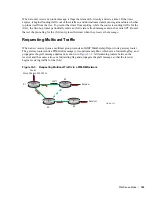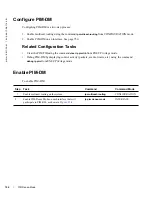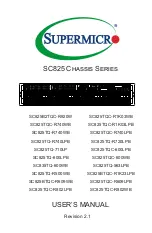
Open Shortest Path First (OSPFv2 and OSPFv3) |
735
OSPFv3 Authentication using IPsec: Configuration Notes
OSPFv3 authentication using IPsec is implemented according to the specifications in RFC 4552,
including:
•
To use IPsec, you configure an authentication (using AH) or encryption (using ESP) security policy on
an interface or in an OSPFv3 area. Each security policy consists of a security policy index (SPI) and
the key used to validate OSPFv3 packets. After IPsec is configured for OSPFv3, IPsec operation is
invisible to the user.
•
Only one security protocol (AH or ESP) can be enabled at a time on an interface or for an area.
IPsec AH is enabled with the
ipv6 ospf authentication
command; IPsec ESP is enabled with the
ipv6 ospf encryption
command.
•
The security policy configured for an area is inherited by default on all interfaces in the area.
•
The security policy configured on an interface overrides any area-level configured security for the
area to which the interface is assigned.
•
The configured authentication or encryption policy is applied to all OSPFv3 packets transmitted
on the interface or in the area. The IPsec security associations (SAs) are the same on inbound and
outbound traffic on an OSPFv3 interface.
•
There is no maximum AH or ESP header length because the headers have fields with variable
lengths.
•
Manual key configuration is supported in an authentication or encryption policy (dynamic key
configuration using the Internet Key Exchange (IKE) protocol is not supported).
•
In an OSPFv3 authentication policy:
•
AH is used to authenticate OSPFv3 headers and certain fields in IPv6 headers and extension
headers.
•
MD5 and SHA1 authentication types are supported; encrypted and unencrypted keys are
supported.
•
In an OSPFv3 encryption policy:
•
Both encryption and authentication are used.
•
IPsec security associations (SAs) are supported only in transport mode (tunnel mode is not
supported).
•
ESP with null encryption is supported for authenticating only OSPFv3 protocol headers.
•
ESP with non-null encryption is supported for full confidentiality.
•
3DES, DES, AES-CBC, and NULL encryption algorithms are supported; encrypted and
unencrypted keys are supported.
•
To configure an IPsec security policy for authenticating or encrypting OSPFv3 packets on a physical,
port-channel, or VLAN interface or OSPFv3 area, perform any of the following tasks:
•
Configuring IPsec Authentication on an Interface
•
Configuring IPsec Encryption on an Interface
Note:
You may encrypt all keys on a router by using the
service password-encryption
command in
global configuration mode. However, this command does not provide a high level of network security. To
enable key encryption in an IPsec security policy at an interface or area level, specify
7
for
[
key-encryption-type
] when you enter the
ipv6 ospf authentication ipsec
or
ipv6 ospf encryption ipsec
command.
Summary of Contents for Force10 E300
Page 1: ...FTOS Configuration Guide FTOS 8 4 2 7 E Series TeraScale C Series S Series S50 S25 ...
Page 32: ...32 w w w d e l l c o m s u p p o r t d e l l c o m ...
Page 132: ...132 802 1X w w w d e l l c o m s u p p o r t d e l l c o m ...
Page 310: ...310 Configuration Replace and Rollback w w w d e l l c o m s u p p o r t d e l l c o m ...
Page 330: ...330 Dynamic Host Configuration Protocol w w w d e l l c o m s u p p o r t d e l l c o m ...
Page 402: ...402 High Availability w w w d e l l c o m s u p p o r t d e l l c o m ...
Page 462: ...462 Interfaces w w w d e l l c o m s u p p o r t d e l l c o m ...
Page 482: ...482 IPv4 Addressing w w w d e l l c o m s u p p o r t d e l l c o m ...
Page 506: ...506 IPv6 Addressing w w w d e l l c o m s u p p o r t d e l l c o m ...
Page 582: ...582 Layer 2 w w w d e l l c o m s u p p o r t d e l l c o m ...
Page 642: ...642 Multicast Source Discovery Protocol w w w d e l l c o m s u p p o r t d e l l c o m ...
Page 662: ...662 Multiple Spanning Tree Protocol w w w d e l l c o m s u p p o r t d e l l c o m ...
Page 690: ...690 Object Tracking w w w d e l l c o m s u p p o r t d e l l c o m ...
Page 754: ...754 PIM Dense Mode w w w d e l l c o m s u p p o r t d e l l c o m ...
Page 784: ...784 PIM Source Specific Mode w w w d e l l c o m s u p p o r t d e l l c o m ...
Page 800: ...800 Power over Ethernet w w w d e l l c o m s u p p o r t d e l l c o m ...
Page 876: ...876 Quality of Service w w w d e l l c o m s u p p o r t d e l l c o m ...
Page 892: ...892 Routing Information Protocol w w w d e l l c o m s u p p o r t d e l l c o m ...
Page 1006: ...1006 Simple Network Management Protocol w w w d e l l c o m s u p p o r t d e l l c o m ...
Page 1018: ...1018 SONET SDH w w w d e l l c o m s u p p o r t d e l l c o m ...
Page 1048: ...1048 Broadcast Storm Control w w w d e l l c o m s u p p o r t d e l l c o m ...
Page 1096: ...1096 Uplink Failure Detection UFD w w w d e l l c o m s u p p o r t d e l l c o m ...
Page 1098: ...1098 Upgrade Procedures w w w d e l l c o m s u p p o r t d e l l c o m ...
Page 1196: ...1196 C Series Debugging and Diagnostics w w w d e l l c o m s u p p o r t d e l l c o m ...
Page 1252: ...1252 Standards Compliance w w w d e l l c o m s u p p o r t d e l l c o m ...
Page 1262: ...1262 Index w w w d e l l c o m s u p p o r t d e l l c o m ...


